Affordable Dual Core from AMD: Athlon 64 X2 3800+
by Anand Lal Shimpi on August 1, 2005 9:36 AM EST- Posted in
- CPUs
Multitasking Content Creation
MCC Winstone 2004
Multimedia Content Creation Winstone 2004 tests the following applications in various usage scenarios:. Adobe® Photoshop® 7.0.1As you can see above, Lightwave is part of the MCC Winstone 2004 benchmark suite. As an individual application, Lightwave does manage to get a healthy performance benefit with multithreaded rendering enabled, especially when paired with Hyperthreading enabled CPUs like the Pentium 4s here today. All chips were tested with Lightwave set to spawn 4 threads.
. Adobe® Premiere® 6.50
. Macromedia® Director MX 9.0
. Macromedia® Dreamweaver MX 6.1
. Microsoft® Windows MediaTM Encoder 9 Version 9.00.00.2980
. NewTek's LightWave® 3D 7.5b
. SteinbergTM WaveLabTM 4.0f
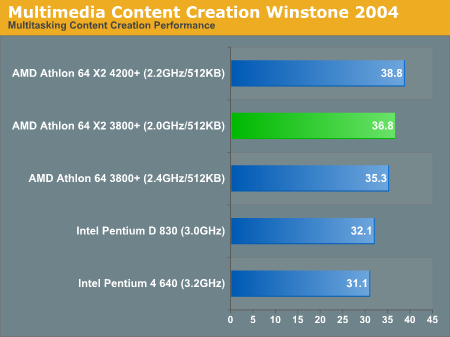
ICC SYSMark 2004
The first category that we will deal with is 3D Content Creation. The tests that make up this benchmark are described below:"The user renders a 3D model to a bitmap using 3ds max 5.1, while preparing web pages in Dreamweaver MX. Then the user renders a 3D animation in a vector graphics format."
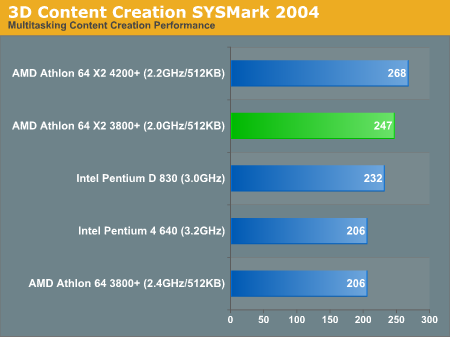
"The user uses Premiere 6.5 to create a movie from several raw input movie cuts and sound cuts and starts exporting it. While waiting on this operation, the user imports the rendered image into Photoshop 7.01, modifies it and saves the results. Once the movie is assembled, the user edits it and creates special effects using After Effects 5.5."
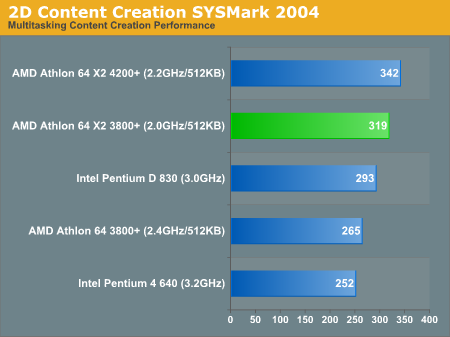
"The user extracts content from an archive using WinZip 8.1. Meanwhile, he uses Flash MX to open the exported 3D vector graphics file. He modifies it by including other pictures and optimizes it for faster animation. The final movie with the special effects is then compressed using Windows Media Encoder 9 series in a format that can be broadcast over broadband Internet. The web site is given the final touches in Dreamweaver MX and the system is scanned by VirusScan 7.0."
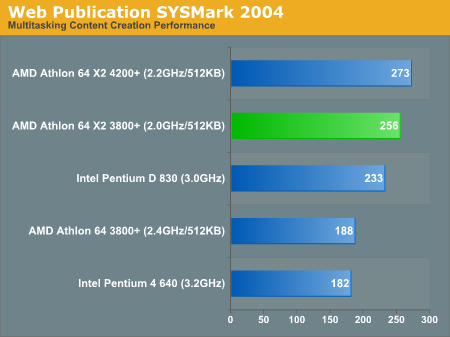
Mozilla + Media Encoder
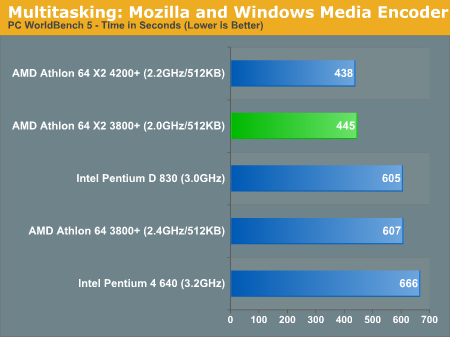










109 Comments
View All Comments
masher - Tuesday, August 2, 2005 - link
> "It is the core itself that increases the cost."True enough-- but a die twice as large shouldn't be over twice the cost...unless your defect rate is pretty high. With a high defect rate, a double-sized die doesn't mean half the yield..it means 1/3 or less.
Intel's dual-core dies are twice as large as their single cores...AMDs are a bit smaller due to the already-embedded HT glue. If the defect rates were anywhere close, then AMD should be able to sell dual-core chips for a smaller premium than Intel. Since they aren't (which likely means can't), we must assume they're still having a fairly high defect rate.
SDA - Tuesday, August 2, 2005 - link
They could also just be charging a premium for the hot new thing. I suspect some of it has to do with AMD wanting to be known as high-end.. when people see Athlons in budget PCs all the time, Athlon becomes associated with budget.Defect rate works too, though. I'm just throwing out other possibilities. Either way, I think we can agree that the CPUs don't cost more because of slick interconnect technology.
krisia - Tuesday, August 2, 2005 - link
Hmmm, hasn't AMD said they've planned for dual core all along and already had tech in their single core chips to support it? So, now they decide to charge for the tech? The thing anand fails to mention is that 40% more money for 10-20% performance gain is not a "clear choice". The choice is much less clear in fact, if you consider you can't buy a X2 3800 yet...SDA - Tuesday, August 2, 2005 - link
40%? The X2 3800+ is supposed to cost $354, but the D 830 is $318 at NewEgg. That looks like a 10% price increase for a 10-20% performance increase AND a cooler processor. Seems like a fairly easy decision to me.If you are suggesting that the inability to perform basic arithmetic is a reason to get the Pentium D, I concur. ;)
krisia - Tuesday, August 2, 2005 - link
If you did the math, then you'd know I was referring to the entry price for the D820. Which is the value entry into dual core? No?SDA - Tuesday, August 2, 2005 - link
The AT review deals with the D 830, not the D 820. You used the numbers from the review and made your remark in the comments section of said review, and yet you feel it's obvious that you're referring to an unreviewed product even if you don't explicitly state such?Let's leave that behind us, though. There is a very simple flaw in your comparison: you're comparing SYSTEM performance differences to PROCESSOR price differences. How about comparing the build prices of an X2 3800+ to a comparably equipped (same amount of memory, same non-core components, all of that) D 820 system, then looking at the performance difference?
If you're too lazy to do the math (and in fairness, it's a PITA to add up components just for the sake of an argument) I'll just explain it simply: it's an 8-15% price boost for 10-20% better performance and a considerably cooler-running processor (and thus, if you plan the system properly, a quieter system).
Before you get defensive, I'm not trying to say that your 820 was a poor choice. I'm certain that you made the perfect choice for your situation. However, it is clear that the 3800+ is a good value in its intended niche.
krisia - Tuesday, August 2, 2005 - link
Ok, the OP didn't reference the anandtech article, only the Pentium D lineup.It's just fun sometimes to do the unconventional or unpopular. :)
SDA - Tuesday, August 2, 2005 - link
I bet it is. Just try to think everything out ahead of time so you don't end up unable to counter the last argument against your "unconventional or unpopular" view.Amplifier - Tuesday, August 2, 2005 - link
First!Hacp - Tuesday, August 2, 2005 - link
I just read toms article and it had alot of synthetic benchmarks and very few real world benchmarks............... Except the ones that favor Intel........